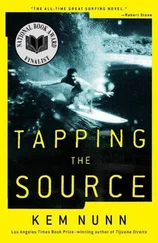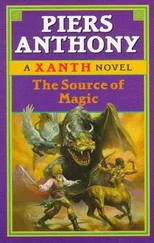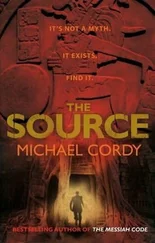Джеймс Миченер - The Source
Здесь есть возможность читать онлайн «Джеймс Миченер - The Source» весь текст электронной книги совершенно бесплатно (целиком полную версию без сокращений). В некоторых случаях можно слушать аудио, скачать через торрент в формате fb2 и присутствует краткое содержание. Год выпуска: 1983, ISBN: 1983, Издательство: Random House, Inc., Жанр: История, на английском языке. Описание произведения, (предисловие) а так же отзывы посетителей доступны на портале библиотеки ЛибКат.
- Название:The Source
- Автор:
- Издательство:Random House, Inc.
- Жанр:
- Год:1983
- ISBN:9780449211472
- Рейтинг книги:5 / 5. Голосов: 1
-
Избранное:Добавить в избранное
- Отзывы:
-
Ваша оценка:
- 100
- 1
- 2
- 3
- 4
- 5
The Source: краткое содержание, описание и аннотация
Предлагаем к чтению аннотацию, описание, краткое содержание или предисловие (зависит от того, что написал сам автор книги «The Source»). Если вы не нашли необходимую информацию о книге — напишите в комментариях, мы постараемся отыскать её.
The Source — читать онлайн бесплатно полную книгу (весь текст) целиком
Ниже представлен текст книги, разбитый по страницам. Система сохранения места последней прочитанной страницы, позволяет с удобством читать онлайн бесплатно книгу «The Source», без необходимости каждый раз заново искать на чём Вы остановились. Поставьте закладку, и сможете в любой момент перейти на страницу, на которой закончили чтение.
Интервал:
Закладка:
“She was good enough for Yigael Yadin at Hazor,” Dr. Bar-El explained.
“Oh, that the girl? How’d you get her?”
“We’re training some great artists in this country,” the little pottery expert said, and Cullinane thought: I must remember to titillate their national pride. I must. Aloud he said, “If we’ve got the girl who did the art work for Hazor, we’re lucky.”
“We are lucky,” Dr. Bar-El said, almost defensively.
Now all grew quiet as they neared the point from which the mound to be excavated would first be seen. Cullinane leaned forward, tense with excitement. To the north substantial hills appeared, and from time unremembered they had protected this road from the marauders of Lebanon. To the south matching hills were beginning to rise, offering security in that direction. A small valley was thus being formed, and along its northern edge short, sharp fingers of rock jutted out like opened hands, warding off anyone who might want to attack the ancient lifeline along which so much wealth had traveled. Dr. Bar-El turned a corner, straightened out the jeep, and drove for a few minutes. Then it loomed ahead—the mysterious target.
It was Makor, a barren elliptical mound standing at the foot of one of the projecting spurs and rising high in the air. It was difficult to believe that it was real, for it had two strange characteristics: its top plateau was quite flat, as if some giant hand had smoothed it down; and the visible flanks of the mound were perfect earthen slopes, each a glacis forty-five degrees in angle, as if the same monstrous hand had stuck out a finger to round off the edges. It looked unnatural, like a fortress without walls, and this impression was augmented by the harsh rocky spur that rose to the rear, by the hills that rose behind that, and by the rugged mountains which backed up everything. The mound was thus the terminal point of a chain of fortifications, the lowest of four descending steps, and it was perfectly placed both for its own protection and for guarding the important road that passed its feet.
Its full name was Tell Makor, which signified that the local citizens knew it was not a natural mound, laid down by tectonic forces, but the patiently accumulated residue of one abandoned settlement after another, each resting upon the ruins of its predecessor, reaching endlessly back into history. From the bare rock on which the first community of Makor had been built, to the grassy top, was seventy-one feet, made up of fallen bricks, ruptured stone walls, broken turrets, bits of prehistoric flint, and, most valuable of all, the fragments of pottery that would, when washed and inspected by Dr. Bar-El, tell the story of this solemn, yet exciting spot.
“We’ve picked the best tell in the country,” Dr. Cullinane assured his team, and he took from his briefcase the preliminary maps made from aerial photographs in which a grid of rectangular squares, ten meters to the side, had been superimposed upon the tell; and at that moment the three archaeologists in the jeep could feel that their will was being imposed upon the mound and would finally squeeze from its secret inner places the remnants of tell once vital existence. Yesterday Tell Makor had been a beautiful elliptical mound sleeping on the road from Akko to Damascus; today it was a carefully plotted target where not one pickaxe would be applied aimlessly.
“Let’s check with the 1/100,000 Palestine map,” Cullinane suggested, and Tabari unfolded a section of that beautiful map, drafted years ago by British engineers. On it the two men made calculations which zeroed in the location of Tell Makor so that other archaeologists around the world could accurately identify it: henceforth the site of their labors would be 17072584, in which the first four numbers indicated the east-west orientation and the last four the north-south. In Israel, in Asia, in the world, there could be no other spot like this, and when the superimposed layers of earth had been penetrated, one by one, the world would be able to say with some exactitude what had happened at 17072584. It was the meticulous re-creation of that history which would occupy John Cullinane and his skilled crew for the ensuing years.
He put aside the maps and jumped from the jeep. With long strides he climbed the steep glacis and finally swung onto the plateau, some two hundred yards long by one hundred and thirty wide. Somewhere in this mound he would start his men digging, and to a disagreeable extent the success or failure of the first years would depend upon how cannily he had chosen; for archaeologists had been known to select their spots without luck and to dig through fruitless levels, while others coming later to the same tell, but with superior insight, had quickly found rewarding layers, one after another. He hoped that he would be one of the lucky ones.
“Deciding where to start?” Tabari asked as he reached the plateau.
The Irishman waited for Dr. Bar-El, then said, “I’m like Sir Flinders Petrie. He organized his digs on the principle that if you command one hundred different communities to build towns on one hundred different mounds, more than ninety will place their major buildings in the northwest area. Why, nobody knows. Possibly because of the sunsets. So naturally I’m inclined toward the northwest, and we can dump our rubble over here.” He pointed to the northern edge of the plateau from which the archaeologists could look down into something not visible from the road: a precipitous gully, called throughout the east a wadi , whose clifflike sides had always protected Makor from armies seeking to establish a siege from the north. The wadi was deep enough to absorb rubble from the entire tell, should any millionaire have enough money to pay for such a total excavation.
The dig at Makor, as planned by Cullinane, would require ten years at a cost of $50,000 a year, and since he had in hand funds only for the first five years, it was essential that he quickly uncover areas of interest; for he had found that people who finance archaeological digs can be depended upon for additional funds if their interest is sustained through the first year, whereas they quickly close their checkbooks if no finds are forthcoming. It was therefore crucial that he locate his trial trenches in the right spots, for even after he had spent ten years uncovering selected levels his team would still have excavated less than fifteen per cent of the site. As he had explained to his board in Chicago, “Our educated guess is that in this tell we may have the remains of about twenty different layers of civilizations. You must understand that for me to peel these off, one by one in proper scientific style until nothing is left but the original perimeter, would require about fifty years. What we’ll do is sink two short exploratory trenches down through all the layers. That’ll take a year, but when we’re through we’ll know in general what’s at hand. Then, in subsequent years, if we get the funds, we’ll go back and dig more deeply in selected areas that promise returns. But bear with me if I repeat that we cannot possibly uncover the entire tell. What we can uncover is a picture of what happened there, and it’s that we’re after.”
“Isn’t it pretty important where you locate those first trenches?” a member had asked.
“That’s what I’ll sweat about for the next six months,” he had replied, and now the moment was at hand when he must make the critical decision.
As he stood that morning on top of the tell whose secrets he must probe, he was no ordinary man, come to the Holy Land with enthusiasm and a shovel; he had won the title archaeologist only at the end of a long period of subtle training. At Harvard he had learned to read Aramaic, Arabic and ancient Hebrew scripts. During graduate work with Professor Albright at Johns Hopkins he had mastered Mesopotamian cuneiform and Egyptian hieroglyphs until he could read them as an average man reads a newspaper. He had taken off a year to attend Carnegie Tech for advanced work in metallurgy, so that he would be able to identify with some certainty the provenience and smelting processes of local metals and their alloys. Later he had spent three winter terms at Ohio State University, taking advanced ceramics, precisely as if he intended making cups and saucers for the rest of his life, and from this experience had trained himself to guess within a hundred degrees centigrade the furnace heat at which any given piece of ancient pottery had been fired; he knew less of the historical relationships of ceramics than a real specialist like Dr. Bar-El, but in technical analysis he excelled her. Following these scientific courses he had lived for a year in New York, studying costume and armor at the Metropolitan Museum, and for another year—one of the best of his life—in the little French university town of Grenoble, specializing in prehistory and the cave art of France. Coincident with his work among the Indians of Arizona he had attended summer sessions at the state university, working on problems of dendrochronology, whereby time sequences in desert areas could be established by comparing the wide rings left in wood by growing seasons which had enjoyed heavy rainfall and the narrow ones left by years of drought. This was followed by a full year at Princeton, enrolled in the Presbyterian Seminary, where he worked with experts on problems of Bible research; but as often happens, one of his most valuable skills he had picked up by himself. As a boy he had found pleasure in collecting stamps; perhaps he was now an archaeologist because of this accident of his childhood, but his Irish father used to growl, “What are you doin’ with them stamps?” He did not know, but when he became a man he vaguely sensed that he ought not to be fooling around with bits of paper and in some fortunate way he shifted to coins, which seemed more respectable, and this field of specialization was to prove of great value in Biblical research. He had written one of the papers which had helped prove that there had been two issues of Jewish shekels: one used in the initial Jewish revolt led by Judah the Maccabee, 166 years before Christ; and a second minted during the final revolt of Bar Kochba, 135 years after Christ. As a result of this paper he was known as a numismatic expert. All these skills, plus others like ancient architecture and the conduct of war in Biblical times, which he had acquired pragmatically during his various digs, he was now ready to apply to Tell Makor, but the location of his two trenches was so important that he intuitively postponed the decision. When the others left the tell, he remained alone, walking aimlessly across the mound, kicking idly at the topsoil to determine its construction.
Читать дальшеИнтервал:
Закладка:
Похожие книги на «The Source»
Представляем Вашему вниманию похожие книги на «The Source» списком для выбора. Мы отобрали схожую по названию и смыслу литературу в надежде предоставить читателям больше вариантов отыскать новые, интересные, ещё непрочитанные произведения.
Обсуждение, отзывы о книге «The Source» и просто собственные мнения читателей. Оставьте ваши комментарии, напишите, что Вы думаете о произведении, его смысле или главных героях. Укажите что конкретно понравилось, а что нет, и почему Вы так считаете.








![Джеймс Купер - Пионеры, или У истоков Саскуиханны [The Pioneers, or The sources of the Susquehannah]](/books/395797/dzhejms-kuper-pionery-ili-u-istokov-saskuihanny-t-thumb.webp)

